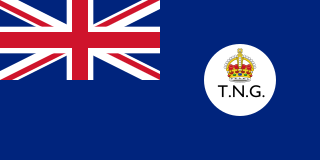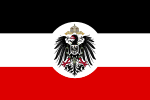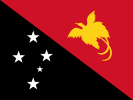
The birds-of-paradise are members of the family Paradisaeidae of the order Passeriformes. The majority of species are found in eastern Indonesia, Papua New Guinea and eastern Australia. The family has 45 species in 17 genera. The members of this family are perhaps best known for the plumage of the males of the species, the majority of which are sexually dimorphic. The males of these species tend to have very long, elaborate feathers extending from the beak, wings, tail or head. For the most part they are confined to dense rainforest habitat. The diet of all species is dominated by fruit and to a lesser extent arthropods. The birds-of-paradise have a variety of breeding systems, ranging from monogamy to lek-type polygamy.

German New Guinea consisted of the northeastern part of the island of New Guinea and several nearby island groups and was the first part of the German colonial empire. The mainland part of the territory, called Kaiser-Wilhelmsland, became a German protectorate in 1884. Other island groups were added subsequently. The Bismarck Archipelago, and the North Solomon Islands were declared a German protectorate in 1885; in the same year the Marshall Islands were bought from Spain for $4.5 million by the Hispano-German Protocol of Rome; Nauru was annexed to the Marshall Islands protectorate in 1888, and finally the Caroline Islands, Palau, and the Mariana Islands were bought from Spain in 1899. German Samoa, though part of the German colonial empire, was not part of German New Guinea.

The flag of Samoa was first adopted from 24 February 1949, for UN Trusteeships, and continuously applied for the state's independence on 1 January 1962. It consists of a red field with a blue rectangle in the canton. The blue rectangle bears the Southern Cross: four large white stars and one smaller star.

The flag of Solomon Islands consists of a thin yellow diagonal stripe divided diagonally from the lower hoist-side corner, with a blue upper triangle and green lower triangle, and the canton charged with five white stars. Adopted in 1977 to replace the British Blue Ensign defaced with the arms of the protectorate, it has been the flag of Solomon Islands since 18 November of that year, eight months before the country gained independence. Although the number of provinces has since increased, the number of stars on the flag that originally represented them remained unchanged.

The Territory of Papua comprised the southeastern quarter of the island of New Guinea from 1883 to 1975. In 1883, the Government of Queensland annexed this territory for the British Empire. The United Kingdom Government refused to ratify the annexation but in 1884 a protectorate was proclaimed over the territory, then called "British New Guinea". There is a certain ambiguity about the exact date on which the entire territory was annexed by the British. The Papua Act 1905 recites that this happened "on or about" 4 September 1888. On 18 March 1902, the Territory was placed under the authority of the Commonwealth of Australia. Resolutions of acceptance were passed by the Commonwealth Parliament, which accepted the territory under the name of Papua.

The coat of arms of Dutch New Guinea was one of a number of national symbols chosen by the Papuan representative body the New Guinea Council in 1961. The coat of arms was not however recorded in the National Committee October 1961 manifesto unlike the flag and anthem. The design on the shield incorporated the new Morning Star flag. The shield was supported by two lesser birds-of-paradise and surrounded by a garland of local flowers and a scroll bearing the motto "Setia, djudjur, Mesra".

The Flag of Bougainville is a symbol of the Autonomous Region of Bougainville in Papua New Guinea. It was originally adopted in 1975 by the secessionist Republic of the North Solomons.

The Territory of New Guinea was an Australian-administered United Nations trust territory on the island of New Guinea from 1914 until 1975. In 1949, the Territory and the Territory of Papua were established in an administrative union by the name of the Territory of Papua and New Guinea. That administrative union was renamed as Papua New Guinea in 1971. Notwithstanding that it was part of an administrative union, the Territory of New Guinea at all times retained a distinct legal status and identity until the advent of the Independent State of Papua New Guinea.

The Raggiana bird-of-paradise, also known as Count Raggi's bird-of-paradise, is a large bird in the bird-of-paradise family Paradisaeidae.

The Territory of Papua and New Guinea, officially the Administrative Union of the Territory of Papua and the Territory of New Guinea, was established by an administrative union between the Australian-administered territories of Papua and New Guinea in 1949. In December 1971, the name of the Territory changed to "Papua New Guinea" and in 1975 it became the Independent State of Papua New Guinea.

The national emblem of Papua New Guinea consists of a bird-of-paradise over a traditional spear and a kundu drum. Designed by Hal Holman, an Australian artist working for the Papuan government, Holman was also involved in the design of the National flag. Both the emblem and the flag was accepted by the House of Assembly of Papua and New Guinea and signed into law as the National Identity Ordinance by the Administrator Sir Leslie Johnson on 24 June 1971. The ordinance came into effect after its publication in the Papua New Guinea Gazette of 1 July 1971.

The Australian flag debate is a periodic question over whether the Australian flag should be changed, particularly to remove the Union Jack from the canton, but also to possibly introduce a completely new design without the Southern Cross. Acknowledgement of the significance of the issues, and corresponding changes are required to reflect Australia's multicultural society, as well as to reflect Australia's immensely rich, and intricate and complex shared history.

New Guinea is the world's second-largest island, with an area of 785,753 km2 (303,381 sq mi). Located in Melanesia in the southwestern Pacific Ocean, the island is separated from Australia by the 150-kilometre wide Torres Strait, though both landmasses lie on the same continental shelf. Numerous smaller islands are located to the west and east.

The postage stamps and postal history of Papua New Guinea originated in the two colonial administrations on the eastern part of the island of New Guinea and continued until their eventual merger, followed by independence in 1975.

Military aircraft insignia are insignia applied to military aircraft to identify the nation or branch of military service to which the aircraft belong. Many insignia are in the form of a circular roundel or modified roundel; other shapes such as stars, crosses, squares, or triangles are also used. Insignia are often displayed on the sides of the fuselage, the upper and lower surfaces of the wings, as well as on the fin or rudder of an aircraft, although considerable variation can be found amongst different air arms and within specific air arms over time.
Haldane Sinclair "Hal" Holman was an Australian sculptor, artist, and designer.

Susan Hareho Karike Huhume was a Papua New Guinean housewife, who, as a schoolgirl, designed the colours of her country's national flag.




























